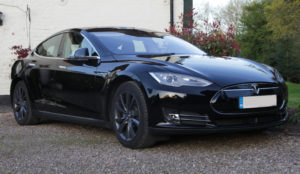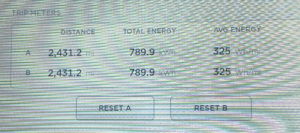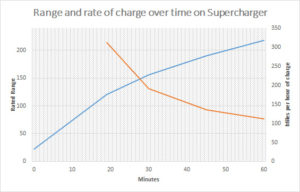A little under a year ago I had the good fortune to drive a Tesla Model S P85+ for a few days. The conclusion of the blog I wrote at that time was that using a Tesla as an everyday vehicle was viable.
Building on that I have recently had the opportunity to drive a 2015 Model S 85 for 4 weeks supplied by
This model is a newer specification than the 2014 model I had before. All models benefit from Over The Air (OTA) software updates periodically but the 2015 model also had a number of hardware changes. Predominantly the addition of radar and additional cameras to support ‘Autopilot’ functions.This model has now been superseded and you can only now buy Dual Motor variants in the UK. This one being a rear drive only derivative. It’s also the least powerful in terms of performance. A mere 382 Rated hp and 325 lb-ft of torque means that the 0-60 time and top speed are 5.4s and 140mph respectively. By no means a slouch but on paper a fair reduction on the performance model originally tested. In reality I would say that the only time this reduced power is obvious is in hard launches from a standing start or very low speeds. Acceleration builds more progressively. This statement should be taken relatively though. With near instant torque delivery, the standard 85 is still blisteringly quick compared to pretty much everything else on the road and certainly compared to anything in the similarly sized 5-door sedan category. As one passenger said, “This ain’t no milk float!”
Cost of running
2431 total miles driven
789.9 kWh total power used
average 325 Wh/mile
My range avg 262 miles based on a full 85kWh battery is pretty much bang on the EPA rated 265 miles.
The cost if domestic charged (i.e. at home) 100% of the time. £97.08 based on 12.29 pence per kWh ( British Gas, Standard tariff, Direct Debit rate for Yorkshire March 2016)
Which equates to 3.9 pence per mile. 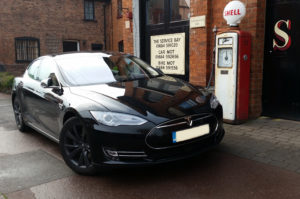 To put that in real terms a Diesel powered car would have to achieve more than 120 mpg to match that price and don’t forget that you don’t have to visit one of those nasty smelly petrol or diesel pumps
To put that in real terms a Diesel powered car would have to achieve more than 120 mpg to match that price and don’t forget that you don’t have to visit one of those nasty smelly petrol or diesel pumps
 To put that in real terms a Diesel powered car would have to achieve more than 120 mpg to match that price and don’t forget that you don’t have to visit one of those nasty smelly petrol or diesel pumps
To put that in real terms a Diesel powered car would have to achieve more than 120 mpg to match that price and don’t forget that you don’t have to visit one of those nasty smelly petrol or diesel pumpsReality though, is that I’ve only put about £12 of domestic electricity in, the rest coming from the free to use charging infrastructure. So the real price is 0.49 pence per mile. Even if it was double that for convenience charging at home it would be only £16.45 per month electricity costs to do 20,000 miles per year.
A 1.2 Nissan micra would be £232 per month in petrol to do the same mileage.
Supercharging
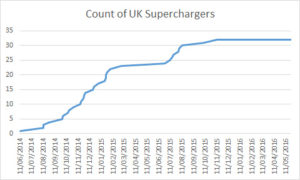 The Tesla Supercharger network is increasing all the time but there has been a notable slow down in the number of new openings recently.
The Tesla Supercharger network is increasing all the time but there has been a notable slow down in the number of new openings recently.There are now 31 active Supercharger stations with a total of 112 available bays. These are free to use for the lifetime of the car and offer the fastest charging option available. Not all chargers are equal and I have found that some of the smaller 2 bay chargers are significantly slower than the larger ones. However, in all cases I have found them to be reliable and faster than any other option. 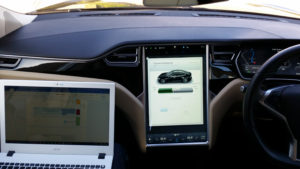 I have queued to use one of the 2 bay chargers but only for a few minutes. I also encountered one Tesla Owner who’s model S was parked on the bay, fully charged for the full duration of my visit (25 minutes). On all occasions I am pleased to report that other owners have been pleasant to chat to if the opportunity arose and a lot of mutual vehicle appreciation. (The same cannot be said for Nissan Leaf owners but that’s a different story). I’ve often used the time taken to charge as an opportunity to use the Tesla as a mobile office.
I have queued to use one of the 2 bay chargers but only for a few minutes. I also encountered one Tesla Owner who’s model S was parked on the bay, fully charged for the full duration of my visit (25 minutes). On all occasions I am pleased to report that other owners have been pleasant to chat to if the opportunity arose and a lot of mutual vehicle appreciation. (The same cannot be said for Nissan Leaf owners but that’s a different story). I’ve often used the time taken to charge as an opportunity to use the Tesla as a mobile office.
 I have queued to use one of the 2 bay chargers but only for a few minutes. I also encountered one Tesla Owner who’s model S was parked on the bay, fully charged for the full duration of my visit (25 minutes). On all occasions I am pleased to report that other owners have been pleasant to chat to if the opportunity arose and a lot of mutual vehicle appreciation. (The same cannot be said for Nissan Leaf owners but that’s a different story). I’ve often used the time taken to charge as an opportunity to use the Tesla as a mobile office.
I have queued to use one of the 2 bay chargers but only for a few minutes. I also encountered one Tesla Owner who’s model S was parked on the bay, fully charged for the full duration of my visit (25 minutes). On all occasions I am pleased to report that other owners have been pleasant to chat to if the opportunity arose and a lot of mutual vehicle appreciation. (The same cannot be said for Nissan Leaf owners but that’s a different story). I’ve often used the time taken to charge as an opportunity to use the Tesla as a mobile office.The Speed of charge is interesting. On two occasions I have seen peaks of 300A at 360V which has seen 300+miles per hour. At the same time I saw both cooling vents in the front grille open and the cooling fans on full. I’m not sure what conditions allowed for such a high rate of charge or, more importantly, why this is a rare occurrence with the normal peak load being around 200A at 360V. I saw both the higher and lower rates of charge on subsequent visits to the same charger, same bay, only person using and similar initial capacity. On one of the higher charge rate occurrences I recorded the rate of charge over a 1 hour period. The initial charge rate was 312miles/hr but towards the end of the hour this had reduced to 112miles/hr as the battery was getting up and over 90% full. Still, the car was charged from 9% (22 miles range) to 91% (218 miles range) in 1 hour. That’s impressive.
CHAdeMO
The CHAdeMO connector available at the Ecotricity chargers (and others) is the proprietary connection for the Nissan Leaf and used by other manufacturers. As a DC supply it does not require the on-board Tesla chargers to convert from AC and can deliver a rated charge of up to 100A 400V. This gives a charging rate of around 100-110 miles per hour and compares the the AC charging at the same stations which tends to be around 60 miles per hour. The Tesla requires an adapter to used the CHAdeMO connector. I requested one of these be supplied with the vehicle and it does work. However at some chargers I’ve had the charging interrupted anything from one to ten times before charging then continued without issue. On one occasion I gave up and resorted to an AC charge. It *might* be that the lever type CHAdeMO connectors are more or alone in this issue. Not enough data to confirm. Nor can I establish if this is a Tesla, Tesla adapter or EcoCity network issue.
Home Charging.
One three occasions I have availed myself of the Tesla’s ability to consume Electricity from a standard 13Amp socket. One one of the occasions I even used a somewhat dubiously supplied property that had some considerable voltage fluctuations. I charged at between 6 and 10 amps at these locations and measured 6 miles per hour charge rate fairly consistently. This might seem slow but consider that an overnight 12 hour charge offers 72 miles of additional range and this will satisfy most people as a trickle charge option. This being the only charging option I have used that costs money, it was important to monitor and minimise these occasions. This is reflected in the figures above.
In Part two of this blog post i’ll talk about Autopilot, The mobile app and some niggles and observations

